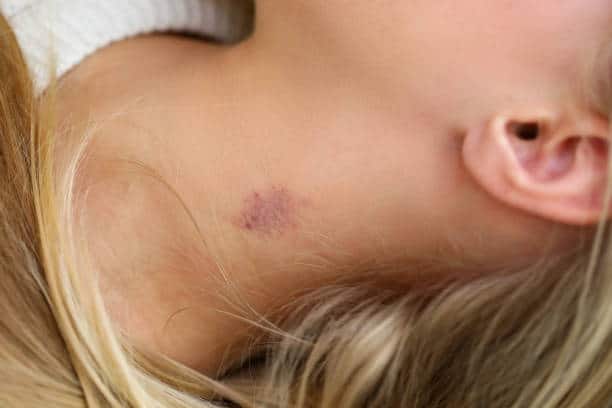Let’s tackle the burning question right away. Hickeys can be a source of embarrassment, so understanding how long they take to fade is crucial. On average, a hickey can linger anywhere from 10 days to 2 weeks. The timeframe largely depends on two things: the size of the bruise and the amount of blood that has pooled beneath the skin. While the aloe vera application won’t erase the hickey overnight, using it twice a day can be beneficial for the healing process.
Table Of Contents
−What Causes a Hickey?
So, how did you end up with that bruise, also romantically termed a “love bite” or “kiss mark”? A hickey is essentially a bruise caused by the breaking of small surface blood vessels due to intense sucking or biting of the skin. The collected blood turns the area red or purple. Understanding these mechanics can arm you with the knowledge to avoid them in the future.

How to Prevent a Hickey
Embarrassment aside, you can take practical steps to sidestep getting a hickey in the first place. Since hickeys typically emerge from passionate activities like intense kissing and sucking, moderating these activities is a logical first step. You might also want to make strategic sartorial choices—like wearing turtlenecks or scarves—to shield vulnerable areas. Additionally, effective communication with your partner regarding your comfort level and boundaries can go a long way.
The Lifecycle of a Hickey
In the realm of hickeys, each bruise undergoes a sort of ‘lifecycle’. Initially, you’ll observe a reddish-purple mark that gradually morphs into shades of green and yellow as the body’s healing process kicks in. Small, shallow hickeys may fade away within a few days to a week, while larger or deeper ones might stick around a bit longer.
Treatment Options for Hickeys
When it comes to treatments, you have a plethora of options. A cold compress is the go-to initial remedy to alleviate swelling and discomfort. Topical treatments, such as aloe vera, can minimize redness and inflammation. A more hands-on approach includes gentle massaging to disperse the blood clot and speed up the healing. For stubborn cases, laser treatments are available but always consult with a healthcare provider for tailored advice.
Natural Remedies to Consider
If you lean toward natural solutions, there are alternatives to treat hickeys effectively. Cold compresses remain an excellent starting point. Aloe vera gel serves as another natural remedy to calm the affected area. Gentle massaging with a soft brush can aid in clot dispersion. Even household items like lemon juice or apple cider vinegar have shown promise in lightening the skin, thus minimizing the appearance of a hickey over time.
How to Conceal a Hickey
If discretion is the aim, several tactics can help you hide that glaring hickey. Clothing is your first line of defense; high-necked garments and scarves work well. Makeup is another tool, although it might require some skill to blend the cover-up seamlessly with your skin. For immediate reduction in size, a cold compress can be your best friend. If all else fails, a self-tanner can even out the skin tone.
When to Consult a Doctor
While hickeys are generally harmless, there are exceptions. If you notice that your hickey is unusually painful, large, or persists beyond two weeks, it could indicate an underlying medical issue like a blood clot or infection. Under such circumstances, seek medical guidance immediately. Pregnant women, in particular, should consult their healthcare provider if they sustain a hickey.
Pregnancy and Hickeys: What to Know
For expectant mothers, the best advice is a cautious approach. There is no scientific evidence to suggest hickeys are harmful during pregnancy, but it’s better to avoid any actions that could lead to bruising. Should you end up with a hickey while pregnant, monitor it carefully for any signs of complications and consult your doctor if necessary.
The Long-Term Consequences of Hickeys
Over time, the majority of hickeys will heal without a trace. However, larger or more severe hickeys can result in scarring or lingering skin discoloration. In rare cases, untreated hickeys can lead to infection. Therefore, timely and appropriate treatment is essential for rapid and complete healing.
How to Safeguard Against Future Hickeys
To dodge future hickeys, open communication with your partner is key. Setting boundaries and discussing your comfort level can help prevent unwanted love bites. A practical tip includes using a cloth or scarf to cover sensitive skin areas during intimate moments. By avoiding the repetition of kissing or sucking on the same area, you reduce the likelihood of a hickey forming.
We hope this comprehensive guide provides you with the knowledge and practical tips to deal with hickeys more effectively. With the right information and measures, you can either prevent hickeys or treat them efficiently when they do occur.

Editorial Staff
Our writers, editors, content managers, and SEO specialist. We all take part in crafting amazing articles. We spend hours ensuring that each article is based on facts, researched, and thorough. You'll never want to click the back button to look for more answers other than here!
